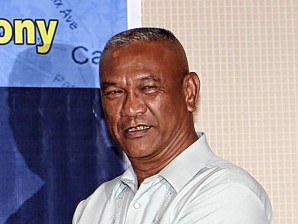
National Disaster Risk Reduction and Management Council (NDRRMC) executive director Benito Ramos. INQUIRER FILE PHOTO
Is the Philippines prepared for the worst?
Let’s say a global pandemic, a powerful typhoon and widespread rioting hit the country all at the same time? Can the government get its act together?
Apparently not, according to the results of a four-day “worst scenario” drill participated in by disaster management personnel with the help of the United States Agency for International Development (USAid) at a five star hotel in Makati.
The drill identified 11 gaps in the country’s calamity preparations—the biggest being that the country did not have a unified national pandemic preparedness plan that could coordinate various agency efforts.
No unified plan
“It’s an eye opener. While different agencies have their own plans, we still have to craft a unifying national plan for pandemic preparedness,” said Defense Undersecretary Eduardo Batac.
National Disaster Risk Reduction and Management Council (NDRRMC) executive director Benito Ramos on Friday admitted the government was still in the process of crafting such a plan to deal with a “worst case scenario.”
“We were awakened by this. What will we do if such a scenario happens? It’s better to over-react rather than do nothing. While it is unlikely to happen, we shouldn’t leave everything to God. We should do something ourselves,” Ramos said.
Ramos spoke at the closing ceremonies of the Philippines Multi-Sectoral Pandemic Disaster Exercise facilitated by the NDRRMC, the US Marine Forces Pacific, and the International Medical Corps at the Dusit Thani Hotel in Makati.
No Mona Lisa song
“Rest assured that we will not be singing (Nat King Cole’s song) Mona Lisa and `They just lie there and they die there.’ We will do something. We assure you,” Ramos said.
Noel Lee Miranda, Asian liaison officer of the Pandemic Preparedness Project, said the worst case scenario they imagined in the drill was a pandemic that would cause a “40 percent to…. 60 percent” absenteeism rate in the country’s work force, especially in essential service sectors—health, food, water, telecommunications, transportation, banking, energy, security.
“Imagine the disruption,” Miranda posed.
Carmencita A. Banatin, director of the Department of Health Emergency Management Staff, said the pandemic could come from viruses like virulent strains of the bird flu or the Ebola virus. It could result in rioting in the streets, hospitals refusing to admit patients except for emergency cases, or even doctors not being able to report for work because they themselves were sick, she projected.
“(The exercises) did not only talk only about absenteeism but also chaos… Riots in the streets,” Banatin said.
“The beauty of this drill is that it is not only about health issues but also involved a multi-sectoral approach: If a pandemic strikes, it could become a security problem because people would be rioting, prices would go up, fuel and water would be in short supply, communications would be disrupted. The economy would suffer,” she added.
No disaster plan
The participants found “11 gaps” in the country’s preparedness including the lack of a “national pandemic disaster plan.”
Other gaps included: the “need to be more proactive in providing guidance and directives to all sectors according to the alert levels;” the need to enhance the capacity of Philippine public health facilities, and addressing “requirement and impact of actions like cremation or mass burial.”
“Effective coordination remains to be a big challenge because agencies have adopted their policies, protocols, and priorities according to their `normal times’ mandate,” said a concluding paper.
“All sectors and agencies need to practice cooperating, voluntarily sharing resources, and not practicing (turf battles),” it added.
The participants also noted the absence of “rules of engagement in containment/buffer zones” and the need for an assessment of the capability for pandemic response of military reservists.